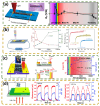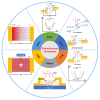Recent Advances in Broadband Photodetectors from Infrared to Terahertz
- PMID: 38675239
- PMCID: PMC11051910
- DOI: 10.3390/mi15040427
Recent Advances in Broadband Photodetectors from Infrared to Terahertz
Abstract
The growing need for the multiband photodetection of a single scene has promoted the development of both multispectral coupling and broadband detection technologies. Photodetectors operating across the infrared (IR) to terahertz (THz) regions have many applications such as in optical communications, sensing imaging, material identification, and biomedical detection. In this review, we present a comprehensive overview of the latest advances in broadband photodetectors operating in the infrared to terahertz range, highlighting their classification, operating principles, and performance characteristics. We discuss the challenges faced in achieving broadband detection and summarize various strategies employed to extend the spectral response of photodetectors. Lastly, we conclude by outlining future research directions in the field of broadband photodetection, including the utilization of novel materials, artificial microstructure, and integration schemes to overcome current limitations. These innovative methodologies have the potential to achieve high-performance, ultra-broadband photodetectors.
Keywords: broadband photodetectors; infrared; photoelectric detectors; terahertz; thermoelectric detectors.
Conflict of interest statement
The authors declare no conflicts of interest.
Figures










References
-
- Long M., Wang P., Fang H., Hu W. Progress, challenges, and opportunities for 2D material based photodetectors. Adv. Funct. Mater. 2018;29:1803807. doi: 10.1002/adfm.201803807. - DOI
-
- Luo X., Zhao F., Du L., Lv W., Xu K., Peng Y., Wang Y., Lu F. Ultrasensitive flexible broadband photodetectors achieving pA scale dark current. npj Flex. Electron. 2017;1:6. doi: 10.1038/s41528-017-0005-x. - DOI
Publication types
Grants and funding
LinkOut - more resources
Full Text Sources

